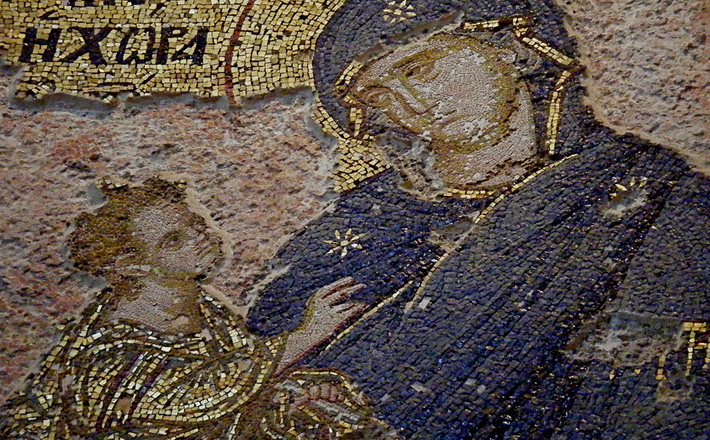Commentary on Titus 2:11-14
During his long tenure at Harvard Divinity School, Krister Stendahl (d. 2008) would occasionally hand out his “Ten Commandments for Biblical Preaching.”
Number Ten on that list was, “No moral lessons on high holy days.” This is an appropriate perspective to have in mind as one approaches the second lessons for Christmas Eve and Christmas Day (Nativity of Our Lord I & II) both of which come from the Letter to Titus. Titus, though the shortest of the Pastoral Epistles, is still a letter full of moral counsel with regard to proper Christian conduct within the church (1:5-9), the family (2:1-10), and the state (3:1-3).
The second lesson for Christmas Eve directly follows such advice, as does the corresponding lesson for Christmas Day. Thus both lessons refer back to ethical counsel that is not included in the public readings (Christmas Eve’s lesson begins with the conjunction “for”/gar; Christmas Day’s text begins with the conjunction “but when”/hote de). It is as though the editors of the RCL took Stendahl’s advice to heart: “No moral lessons on high holy days!”
The preacher, however, will want to read the sections that precede the assigned readings in order to have the wider context of the Christmas lessons in mind. A basic Pauline notion is being articulated here in Titus — the Incarnation has transformed everything. That includes not only the way one thinks (Romans 12:2) but also how one might actually relate to God and God’s good creation, which of course includes one’s neighbor. In other words, God’s favor (charis) is experienced as a transforming power. As Titus 2:13 puts it (using the adjective soterios), God has manifested a “saving grace” in Christ.
The texts from Titus chosen for Christmas Eve and Christmas Day represent the theological highpoints of the Letter to Titus. They are densely packed summaries of the gospel of the incarnation expressed in finely tuned poetic language that articulate a high Christology and the universal soteriological reach (“for all,” 2:11) of God’s grace in the Christ event.
The terminology is similar in both texts, grounded in the classic Pastoral Epistles’ emphasis on the “appearance” or “manifestation” of God’s grace (cf. 1 Timothy 6:14; 2 Timothy 1:9-10, 4:1, 8). The Greek verb translated as “appeared” at 2:11 and 3:4 is epiphaino, from which our English cognate “epiphany” comes. In these specific verbal usages, the reference is to the “first” appearance of Christ in the flesh. The nominal form (epiphaneia) also is in evidence at 2:13 (translated in the NRSV as “manifestation”), which refers to the “2nd” coming of Christ. By means of this *epiphan word group, the strong continuity between the first and the second “manifestations” of Christ is highlighted by the author of Titus.
Though the apocalyptic bent of some forms of North American Christianity might be centered in speculative projections of a violent second adventus of Christ, it is good to remember that the early church was confident that the grace of God was the foundation of both epiphanies. The major difference between the two, this text suggests, is that in the final manifestation of Christ will be one that reveals God’s very glory (doxa; 2:13). That is, in the final epiphany, all of creation will recognize the grace of God as first revealed in the Christ child. “Now,” in the interim between the two epiphanies, it is only by faith (Titus 1:1) that the abundant grace of God is discerned.
The transformation in Christ referred to above is the focus of verse 12. Much has been made in the commentary literature about how the author is evoking common tropes of Hellenistic moral discourse. This includes the terminology for “instruction” (from the Greek tradition of paideia) and the listing of three of the four cardinal virtues of Hellenistic culture (“self control,” “righteousness,” “piety”; absent is “courage”). These virtues are drawn off against “worldly passions” (kosmikas epithymias).
As often pointed out, the virtues are all encompassing in that they focus on self (“self-control”), one’s relations with others (“righteousness”), and with God (“godliness,” i.e., one’s reverence toward God). It is important to note, however, that this language does not simply imitate the ethical mores of Imperial Rome. The virtues are “Christian” in that they are set within the narrative of the Incarnation, a narrative that begins with the birth to Mary, stretches through the public ministry of Jesus, his crucifixion (by the “rulers of this age,” cf. 1 Corinthians 2:8), resurrection and enthronement at the right hand of God. So, Christian “self-control” (sophrosyne), for example, rather than reflecting an accommodation to wider public moral standards, actually trains (or “instructs”) one to resist the values of Empire.
Christian “self-control” is radical in that it recognizes the dangers to self and society (and to one’s relationship with God!) of the “worldly desires” and mores into which one is socialized by the larger public discourse. In antiquity, such a discourse, for instance, priviledged the few with scarce goods at the expense of the many. The narrative of the Incarnation, on the contrary, assured all of access to the abundant good gifts and favor (charis) of a merciful and generous God. What is more radical than “moderation” and “self-control,” one might observe, in a world gone mad with desire for power, money, and prestige?
The syntax of the phrase in verse 13 is much reviewed in the commentary literature. It is brought over into English in the NRSV as “we wait for the blessed hope and the manifestation of the glory of our great God and Savior, Jesus Christ.” The punctuation in the NRSV suggests that “Jesus Christ” is in apposition to something that precedes the comma. But what? Are we to identify “Jesus Christ” as (a) “our great God and Savior” or (b) “the manifestation of the glory of our great God and Savior”? That is, is Jesus identified as “God” in this text? If so, it is a supposedly rare occurrence in the New Testament (but cf. Romans 9:5; John 1:1, 18; 20:28; Hebrews 1:8ff; 2 Peter 1:1; 1 John 5:20).
The confession “Jesus is Lord” (kyrios Iesous) — the actual worship paid to Jesus by the early church, as well as the co-enthronement vision of Psalm 110:1 (the most often cited Old Testament text in the New) — suggests that such a designation of divinity was less problematic for many early Christians than it has been for some New Testament scholars in the modern period. It is appropriate that on this high holy day, one that celebrates the mystery of God’s Incarnation, that we give thanks for the first epiphany “while we wait the blessed hope and the manifestation of the glory of our great God and Savior Jesus Christ.


December 24, 2013